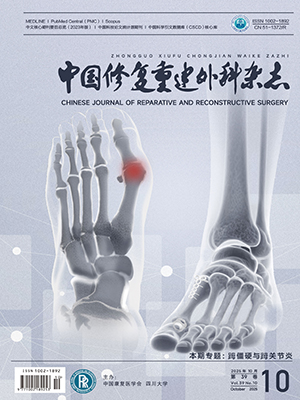Objective To evaluate the therapeutic effect of open-door cervical expansive laminoplasty (ELP) with anchor fixation on flurosis cervical stenosis (FCS). Methods From February 2005 to February 2006, 20 patients with FCS underwent ELP using anchor fixation (group A) and 24 patients with FCS received ELP using conventional silk thread fixation (group B). In group A, there were 11 males and 9 females aged (58.0 ± 11.2) years old, the course of disease ranged from 6 months to 5 years, and the stenosis involved 3 vertebral levels in 3 cases, 4 levels in 8 cases, and 5 levels in 9 cases, and
the sagittal diameter of the cervical spinal canal was (7.30 ± 5.23) mm. While in group B, there were 11 males and 13 females aged (61.0 ± 9.1) years old, the course of disease ranged from 5 months to 5 years, the stenosis involved 3 vertebral levels in 5 cases, 4 levels in 10 cases, and 5 levels in 9 cases, and the sagittal diameter of the cervical spinal canal was (7.11 ± 4.92) mm. No significant differences were evident between two groups in terms of the general information (P gt; 0.05). Before operation and at 24 months after operation, the nerve function was assessed by JOA score, the axial symptom (AS) was evaluated using Chiba 12-point method, and the changes of cervical lordosis index (CLI) and cervical range of motion (CRM) were detected by imaging examination. Results All wounds healed by first intention. All patients were followed up for 24 months. JOA score: in group A, it was improved from 7.4 ± 1.5 before operation to 14.6 ± 2.1 at 24 months after operation with an improvement rate of 61% ± 3%; in group B, the score was increased from 7.1 ± 2.2 to 12.6 ± 2.5 with an improvement rate of 52% ± 5%; significant differences were evident in two groups between before and after operation, and between two groups in terms of the improvement rate (P lt; 0.05). AS score: in group A, it was improved from 6.2 ± 2.1 before operation to 10.8 ± 0.3 at 24 months after operation with an improvement rate of 74% ± 4%; in group B, the score was increased from 6.3 ± 1.9 to 8.8 ± 0.5 with an improvement rate of 39% ± 3%; significant differences were evident in two groups between before and after operation, and between two groups in terms of improvement rate (P lt; 0.05). X-ray films and CT scan at 24 months after operation displayed that there was no occurrence of “breakage of door spindle” or “re-close of door” in two groups, there was no occurrence of anchor loosing in group A, and the molding of the spinal canal was satisfactory in two groups. Preoperatively, the CLI was 11.9 ± 1.9 in group A and 11.3 ± 2.2 in group B and the CRM was (39.5 ± 2.4)° in group A and (40.2 ± 1.8)° in group B. While at 24 months after operation, the CLI was 9.5 ± 2.2 in group A and 8.2 ± 2.8 in group B, and the CRM was (30.6 ± 2.0)° in group A and (28.7 ± 2.4)° in group B, suggesting there was a significant decrease when compared with the preoperative value and group A was superior to group B (P lt; 0.05). The saggital diameter of the cervical spinal canal 24 months after operation was (13.17 ± 2.12) mm in group A and (12.89 ± 3.21) mm in group B, indicating there was a significant difference when compared with the preoperative value (P lt; 0.01). Conclusion Compared with conventional silk thread fixation, ELP using anchor fixation brings more stabil ity to vertebral lamina, less invasion to the posterior muscular-skeletal structure of the cervical spine, sl ight postoperative neck AS, and
satisfactory cl inical outcomes.
Citation: XIA Yingpeng,WAN Jun,YU Bin,ZHANG Xueli,TIAN Rong.. TREATMENT OF FLUROSIS CERVICAL CANAL STENOSIS BY OPEN-DOOR CERVICAL EXPANSIVE LAMINOPLASTY USING ANCHOR FIXATION. Chinese Journal of Reparative and Reconstructive Surgery, 2009, 23(10): 1204-1208. doi: Copy
Copyright © the editorial department of Chinese Journal of Reparative and Reconstructive Surgery of West China Medical Publisher. All rights reserved




